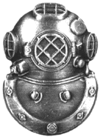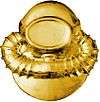Uniform Service Diver Insignia (United States)
The diver insignia (also known as "diver badges") are qualification badges of the uniformed services of the United States which are awarded to servicemen qualified as divers. Originally, the diver insignia was a cloth patch decoration worn by United States Navy divers in the upper-portion of the enlisted service uniform's left sleeve during the first part of World War II, when the rating insignia was worn on the right sleeve. When enlisted rating insignia were shifted to the left sleeve in late World War II, the patch shifted to the upper right sleeve. The diving patch was created during World War II, and became a breast insignia in the late 1960s.
Currently, the United States Navy and the United States Army issue diver insignia and badges denoting degrees of qualification. The United States Coast Guard and United States Marine Corps personnel are eligible to earn most of the naval diver insignia.
United States Maritime Services




.jpg)


.jpg)


United States naval diver insignia are awarded, per degree of qualification, to sailors, marines, and coast guardsmen. The elementary naval diver insignia is the scuba diver insignia, awarded upon qualifying as a basic naval diver. Previously, the scuba diver insignia was awarded in two degrees, one for officers and one for enlisted. The Navy eliminated the scuba diver officer insignia in the 1990s, but it remains in service within the Coast Guard. The silver-colored insignia features an old-fashioned diving mask and open-circuit breathing apparatus.[1]
In 2001, the Marine Corps authorized the creation of a new badge, the combatant diver insignia, attesting to the wearer's closed-circuit rebreather and reconnaissance combat diver training; the gold-colored combatant diver insignia depicts a wetsuit hood, low-profile diving mask, and chest-mounted rebreather.[2]
The naval deep sea diver qualification insignia are awarded in four degrees: second-class diver; first-class diver; master diver; and diving officer. However, the Marine Corps does not award the diving officer insignia to its officers. In the Navy, the master diver is the most qualified diver; he must be a chief petty officer before applying to attend the master diver course.[3]
The diving medical officer and the diving medical technician insignia are awarded to naval medical personnel qualified as divers or medical technicians, respectively. The diving medical insignia resembles the master diver insignia, but is decorated with a caduceus. The diving medical officer insignia is gold in color while the enlisted version – the diving medical technician insignia – is silver in color. Since the Marine Corps and the Coast Guard have no organic medical officers, they do not issue the diving medical officer insignia.[1][3]
Like the Navy's surface, submarine, and aviation enlisted specialties, dive-qualified enlisted personnel place a term after the sailor’s rating; for example, if Petty Officer Second-Class Jones is dive-qualified, he is referred to, in writing, as PO2 (DV) Jones.
The only non-armed service of the United States that awards diver badges is the National Oceanic and Atmospheric Administration Commissioned Corps (NOAA Corps). NOAA Corps officers qualified as NOAA divers may wear the NOAA diver insignia after authorization by the Director of the NOAA Corps. The NOAA diver insignia is a gold-colored pin consisting of a NOAA Corps device surrounded by two dolphins.[4]
United States Army
| Diver badges | |
|---|---|
 | |
| Awarded by United States Army | |
| Type | Badge |
| Status | Currently awarded |
| Precedence | |
| Next (higher) | Flight surgeon badge |
| Next (lower) | Explosive ordnance disposal badge[5] |
The United States Army issues diver badges in four degrees (second-class diver, salvage diver, first-class diver, and master diver; if you are an Army engineer diver) and special operations diver badges in two degrees (diver and diving supervisor). The second-class and first-class diver badges are identical to those issued by U.S. naval forces. The Army does not issue officer or medical diver badges; however, Navy-awarded diving officer, diving medical officer, and diving medical technician badges are authorized for wear on Army uniforms with written approval from the United States Army Human Resources Command.[6][7][8]
On 17 September 2004, the scuba diver badge was discontinued in lieu of a new special operations diver badge and an additional grade, the special operations diving supervisor badge, was created. Prior to this change, the basic scuba diver badge was the same for all of the U.S. armed forces. The new design includes sharks, symbolizing speed, stealth, and lethal efficiency, and two Fairbairn-Sykes Fighting Knives in saltire, representing the heritage of OSS operational swimmers during World War II. The combat diver qualification and combat diving supervisors courses are taught by Company C, 2nd Battalion, 1st Special Warfare Training Group at the Special Forces Underwater Operations School, Naval Air Station Key West.[9][10][7][8]
United States Air Force
The United States Air Force issues the same scuba diver insignia as the U.S. maritime services, with no other degrees of qualification, as their scuba badge is presented to graduates of the Air Force Combat Diver Course at the Navy Diving Salvage and Training Center, Naval Support Activity Panama City.[11][12]
See also
- United States military divers
- Badges of the United States Air Force
- Badges of the United States Army
- Badges of the United States Coast Guard
- Badges of the United States Marine Corps
- Badges of the United States Navy
- Military badges of the United States
- Awards and decorations of the National Oceanic and Atmospheric Administration
- Obsolete badges of the United States military
References
- 1 2 U.S. Coast Guard Uniform Regulation, COMDTINST M1020.6F, United States Coast Guard, dated March 2012, last accessed 14 July 2012
- ↑ "CHANGES TO DIVER QUALIFICATION REQUIREMENTS, POLICY, AND UNIFORM REGULATIONS FOR RELATED DIVER INSIGNIA". United States Marine Corps. 2002-03-14. Retrieved 2008-11-15.
- 1 2 U.S. Marine Corps Uniform Regulation MCO P1020.34G, Chapter 4, United States Marine Corps, last updated 29 October 2009, last accessed 14 July 2012
- ↑ NOAA Corps Commissioned Personnel Center, NOAA Corps Directives, NOAA Corps, last accessed 13 Nov 11
- ↑ Army Regulation 600-8-22 Military Awards (24 June 2013). Table 8-1, U.S. Army Badges and Tabs: Orders of precedence. p. 120
- ↑ U.S. Army Regulation 670–1, Uniforms and Insignia, Wear and Appearance of Army Uniforms and Insignia, Department of the Army, dated 3 February 2005, rapid action revision dated 11 May 2012, last accessed 14 July 2012
- 1 2 Army Regulation 600-8-22 Military Awards (24 June 2013).
- 1 2 AR611-75, Management of Army Divers; dated 20 July 2007; retrieved 27 August 2011
- ↑ "Diver Badges". Institute of Heraldry. United States Department of the Army. Archived from the original on 2008-06-14. Retrieved 2008-11-15.
- ↑ "Special Forces Underwater Operations" (PDF). John F. Kennedy Special Warfare Center and School. United States Army. 2007-07-05. Retrieved 2008-11-16.
- ↑ Cuttita, Chrissy (2006-03-16). "First Air Force dive course graduates 17 Airmen". Air Force Link. United States Air Force. Retrieved 2008-11-15.
- ↑ AFI36-2903: Dress and Personal Appearance of Air Force Personnel, dated 18 Jul 11, last accessed 21 Aug 11